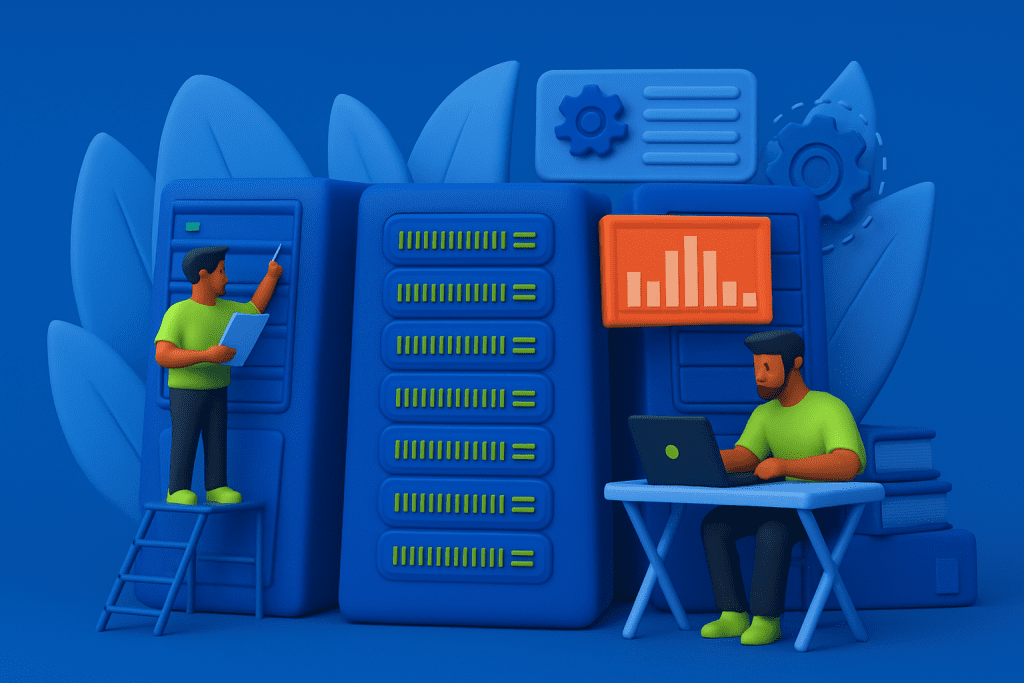Websites and apps today get more traffic than ever. An online store during a festive sale or a popular app at peak hours might see thousands of people trying to connect at the same time. If all of that traffic goes to a single server, it quickly becomes overloaded. The result is slow performance, errors, or even downtime.
The issue comes from a direct client-to-server setup, where every request is sent straight to one server. No matter how strong that server is, it can only handle so much before it breaks under pressure.
A reverse proxy solves this problem. It sits in front of your servers and works like a load balancer, distributing traffic evenly across multiple servers. This way, no single server carries the full burden, and users get faster, more reliable access to your website or app.
What Is a Reverse Proxy?
A reverse proxy is a server that sits between the user (client) and the backend servers where your website or app actually runs. When someone visits your site, their request doesn’t go directly to your server. Instead, it first goes to the reverse proxy, which then decides which backend server should handle it.
This setup helps manage traffic, improve security, and reduce the load on individual servers.
Reverse Proxy vs. Forward Proxy
- A forward proxy works on the client’s side. For example, a company may use a proxy so that employee devices connect to the internet through it. The proxy hides or controls what the client can access.
- A reverse proxy works on the server’s side. Visitors don’t even know it exists. It hides your backend servers, protects them, and balances the traffic among them.
Core Functions of a Reverse Proxy
A reverse proxy does more than just share traffic between servers. It also takes care of several important jobs that make websites faster, safer, and more reliable.
1. Request Forwarding and Routing
When a user sends a request, the reverse proxy decides which backend server should handle it. This keeps traffic balanced and prevents any one server from becoming overloaded.
2. SSL Termination
Handling HTTPS traffic (encryption and decryption) takes up server resources. A reverse proxy can take over this task—called SSL termination—so that backend servers can focus on running the application instead of dealing with encryption.
3. Caching Frequently Requested Content
If many users request the same content (like a homepage or product image), the reverse proxy can store a copy temporarily and serve it directly. This speeds up responses and reduces the workload on backend servers.
4. Compressing Responses for Efficiency
Before sending data back to users, a reverse proxy can compress files like HTML, CSS, or JavaScript. Smaller files mean faster load times, especially for users on slower connections.
5. Security Features
A reverse proxy also adds an extra layer of protection by:
- Filtering suspicious requests.
- Hiding backend server details from the public.
- Helping protect against DDoS (Distributed Denial of Service) attacks by spreading traffic or blocking malicious requests.
How Reverse Proxies Improve Load Distribution
One of the biggest advantages of a reverse proxy is its ability to spread out traffic so that no single server is overwhelmed. This is known as load distribution.
Evenly Spreading Requests
Instead of sending all requests to one server, the reverse proxy divides them among several backend servers. This keeps things balanced and ensures all servers are used efficiently.
Preventing Overload
If one server tries to handle too many users at once, it can slow down or even crash. With a reverse proxy, the traffic is shared, so each server only carries part of the load. This prevents downtime and keeps the website or app running smoothly.
Session Persistence
In some cases, a user needs to stay connected to the same server during their visit—like when they’re logged into an account or shopping online. A reverse proxy can make sure that all of that user’s requests go to the same server. This is called session persistence, and it improves the user experience by keeping sessions stable.
Benefits of Reverse Proxies for Businesses and Developers
Using a reverse proxy is not just about handling traffic—it directly benefits both businesses and developers who need stable, scalable systems.
Better Scalability for Growing Traffic
As your website or app gains more users, a reverse proxy makes it easy to add more backend servers. Instead of replacing one overloaded server with a bigger one, you simply connect another server to the pool, and the proxy distributes traffic. This makes scaling smooth and cost-effective.
Improved Website Performance
By caching content, compressing responses, and sharing traffic, reverse proxies reduce latency (the delay before data starts moving). For users, this means faster page loads and a better overall experience.
Enhanced Security Layer
A reverse proxy acts like a shield in front of your backend servers. It hides server details from attackers, helps block malicious traffic, and reduces the risk of DDoS attacks. This extra layer of defense makes your infrastructure safer without adding complexity for users.
Cost Efficiency
Because the proxy ensures servers are used more evenly, you get the most out of your existing infrastructure. Instead of one server being overloaded while another sits idle, the proxy balances the load, which saves money on hardware and maintenance in the long run.
Reverse Proxy vs. Load Balancer: What’s the Difference?
A reverse proxy and a load balancer are closely related, and in many cases, people use the terms interchangeably. But there are some important differences to understand.
Overlap
Both a reverse proxy and a load balancer sit in front of backend servers and control how traffic is handled. Both can improve performance, reduce overload, and add security.
Distinctions
- Reverse Proxy: Acts as a middleman between clients and servers. It can do load balancing, but also offers extra features like SSL termination, caching, content compression, and security filtering.
- Load Balancer: Focuses mainly on distributing traffic evenly across servers. It’s specialized for high-performance traffic management but doesn’t always provide the additional features a reverse proxy can.
When to Use Which
- A reverse proxy is often enough for small to mid-sized businesses or applications. It gives you load distribution plus added benefits like caching and SSL offloading.
- A dedicated load balancer is better for very large systems that handle massive amounts of traffic (for example, global e-commerce platforms, streaming services, or large-scale SaaS). These environments need advanced algorithms, redundancy, and high availability features that a simple reverse proxy might not fully cover.
As websites and apps face more users and heavier traffic, stability and performance become critical. A reverse proxy plays an important role in modern infrastructure by distributing load, improving speed, and adding a protective security layer in front of servers.
Choosing the right setup ensures that your application can handle growth without sacrificing performance or security.
At Bagful, we integrate reverse proxy and load balancing into our hosting solutions to give you stability from day one. Whether you’re a startup preparing for growth or an established business handling high traffic, our infrastructure ensures your website runs smoothly, securely, and without bottlenecks.













